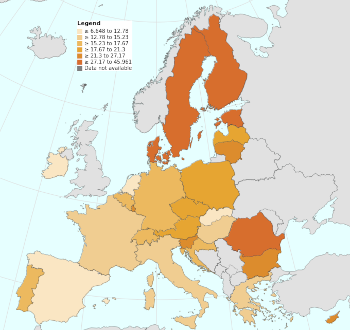Critical Materials
April 22, 2024
Human culture has been defined by
materials to the extent that
archaeologists have named some periods of
human activity by their premier materials. In the so-called
three-age system, we've lived in the
Stone Age, which ended about 4000
BC; the
Bronze Age, which started around 2500 BC, when
metalworking was first practiced; and the
Iron Age, which started around 1000 BC. The proposed
Anthropocene, the present age of man, could be defined by increased
trace elements, notably
radionuclides, in the
geological record. The
mass of
synthetic materials now outweighs all
Earth's biomass.[1]
Since
gold is the least
reactive metal, it occurs in
nature as the metal, itself, so it was the first metal used by man. After gold, primitive man discovered ways to release other metals from their
ores by
heating. The
ancients were able to
smelt silver,
mercury,
copper,
lead,
tin, and finally,
iron.
Bronze, an
alloy of
copper and
tin, was a
stronger metal than copper, and it had sufficient properties to launch the Bronze Age.

Hesiod, Works and Days, lines 150-151, scanned from the author's copy of ref. 2. The translation is "Their armor was of bronze, and their houses of bronze, and of bronze were their implements: there was no black iron."[2]
Iron smelting, the
extraction of
iron from its common ores, is much more difficult than the extraction of the other metals since it requires higher
temperature. The
reduction of the common
iron ore,
hematite (
Fe2O3), using
carbon as a
reducing agent is straightforward; viz.,
2Fe2O3 + 3C -> 4Fe + 3CO2
This so-called
carbothermic reaction uses readily available materials, but it happens at higher temperatures than encountered for the smelting of the other metals known to the ancients. These temperatures were achieved after development of
bloomery furnaces.

The 150th
anniversary of the
Periodic Table was in
2019,
proclaimed the
International Year of the Periodic Table of Chemical Elements (IYPT2019) by the
United Nations General Assembly.
Russian chemist,
Dmitri Mendeleev (1834-1907), organized all the
chemical elements known in 1869 into a periodic table based on
atomic weight.[3]
(Wikimedia Commons image of Dmitri Mendeleev in 1887, modified for artistic effect.)
Fewer than half of the 118 elements of today's periodic table were known to Mendeleev. The present
plethora of 118 elements has given
scientists a huge
palette of materials with which to create
compounds of
technological importance. Most prominent among these are alloys for
high strength permanent magnets,
lithium cathodes for
rechargeable batteries, and high temperature alloys for
gas turbine engines and
turbine generators. The essential problem is extraction of large quantities of these sometimes trace elements from the
Earth's crust.
The
uneven distribution of needed elements adds
geopolitics to the extraction problem. Notably,
China produces 60 percent of the
rare earth elements needed for such things as
NdFeB magnets used in
motors and
generators,
phosphors and
catalysts.[4] China also
imports rare earth elements from other
countries to process nearly 90 percent of worldwide rare earths into
end products.[4] As shown in the following table, lithium is likewise concentrated in just a few countries.
The
United States Department of Energy has designated 54 materials as being of critical importance.[6-7] These are listed in the following table and include lithium and all of the rare earth elements with the exception of
scandium and
promethium.
Human
lust for raw materials is not expected to
slake any time soon. As reported by the
Guardian, an
analysis by the
United Nations finds that worldwide extraction of raw materials is expected to increase by 60% by 2060.[8] This follows on the nearly 400% growth seen since
1970.[8] Not surprisingly, raw material extraction is responsible for major
environmental impact in
biodiversity loss,
air pollution, and
water stress.[8] Building an
environmentally friendly future is also problematic, since an
electric vehicle has nearly ten times the critical material content of a conventional
internal combustion engine automobile.[8]
 European Union statistics
European Union statistics show that
Europeans consume 15
metric tons of materials per person
annually.[8] The consumption ranges from 7 metric tons per person for
The Netherlands to
Finland's 46 (see figure).[8]
Finland also generates the most per capita waste (20,993
kg), about seven times that of the least wasteful country,
Croatia (1,483 kg).[8] The average waste generation of a European Union
citizen in 2020 was 4,815 kg.[8]
(Map from the European Union Eurostat showing the annual raw material consumption. Click for larger image.)
References:
- Emily Elhacham, Liad Ben-Uri, Jonathan Grozovski, Yinon M. Bar-On, and Ron Milo, "Global human-made mass exceeds all living biomass," Nature. vol. 588, no. 7838 (December 9, 2020), pp. 442-444, https://doi.org/10.1038/s41586-020-3010-5.
- Hugh G. Evelyn-White, Trans., "Hesiod, The Homeric Hymns and Homerica," William Heinemann/The Macmillan Co., London/New York, 1914, pp. 12-13 (via the Internet Archive).
- Dmitri Mendeleev, "Die periodische Gesetzmäßigkeit der Elemente," Annalen der Chemie und Pharmacie, vol. VIII. Supplement (1871), pp. 133-229. An image of Mendeleev's 1871 periodic table can be found at Wikimedia Commons, here.
- Gracelin Baskaran, "What China’s Ban on Rare Earths Processing Technology Exports Means," Center for Strategic and International Studies, January 8, 2024.
- Govind Bhutada, "This chart shows which countries produce the most lithium," World Economic Forum, January 5, 2023.
- What Are Critical Materials and Critical Minerals?, Critical Minerals & Materials Program, United States Department of Energy.
- Diana J. Bauer, Ruby T. Nguyen, Braeton J. Smith, et al., "Critical Materials Assessment," U.S. Department of Energy, July 2023
- Arthur Neslen, "Extraction of raw materials to rise by 60% by 2060, says UN report," The Guardian (UK), January 31, 2024.
- Communication from the Commission to the European Parliament, the Council, the European Economic and Social Committee and the Committee of the Regions Critical Raw Materials Resilience: Charting a Path Towards Greater Security And Sustainability, Document 52020DC0474, EUR-Lex, Publications Office of the European Union.
Linked Keywords: Human culture; material; archaeology; archaeologist; three-age system; Stone Age; Anno Domini; BC; Bronze Age; metalworking; Iron Age; Anthropocene; trace element; radionuclide; geological record; mass; chemical synthesis; Earth's biomass; gold; chemical reaction; reactive; metal; nature; ore; heat; heating; ancient history; ancients; smelting; smelt; silver; mercury (element); copper; lead; tin; iron; bronze; alloy; tin; strength of materials; stronge; Hesiod; Works and Days; translation; armor; house; tool; implement; cast iron; black iron; ferrous metallurgy; iron smelting; extractive metallurgy; extraction; temperature; redox; reduction; iron ore; hematite; Fe2O3); carbon; reducing agent; carbothermic reaction; bloomery; metallurgical furnace; anniversary; Periodic Table; 2019; proclamation; proclaim; United Nations General Assembly; Russia; Russian; chemist; Dmitri Mendeleev (1834-1907); chemical element; atomic weight; Wikimedia Commons; plethora; scientist; palette; chemical compound; technology; technological; maximum energy product; high strength permanent magnet; lithium; cathode; rechargeable battery; gas turbine engine; turbine generator; crust (geology); Earth's crust; abundance of elements in Earth's crust; uneven distribution; geopolitics; People's Republic of China; China; rare earth element; neodymium magnet; NdFeB; electric motor; electric generator; phosphor; catalysis; catalyst; import; country; countries; intermediate good; end product; metric ton; percentage; percent; Australia; Chile; Argentina; Brazil; Zimbabwe; Portugal; United States; United States Department of Energy; scandium; promethium; aluminum; gallium; rhodium; antimony; germanium; rubidium; arsenic; hafnium; ruthenium; baryte; barite; holmium; samarium; beryllium; indium; silicon; bismuth; iridium; silicon carbide; cerium; lanthanum; tantalum; cesium; tellurium; chromium; lutetium; terbium; cobalt; magnesium; thulium; manganese; dysprosium<; natural graphite; titanium; silicon steel; electrical steel; neodymium; tungsten; erbium; nickel; vanadium; europium; niobium; ytterbium; fluorine; palladium; yttrium; fluorite; fluorspar; platinum; zinc; gadolinium; praseodymium; zirconium; lust; slake; Guardian; analysis; United Nations; 1970; environmental issue; environmental impact; biodiversity; air pollution; water scarcity; water stress; environmentally friendly; electric vehicle; internal combustion engine; automobile; European Union annual per capita material consumption; European Union; statistics; demographics of Europe; European; consumer; consume; year; annual; The Netherlands; Finland'; kilogram; kg; Croatia; citizenship; citizen; Eurostat.